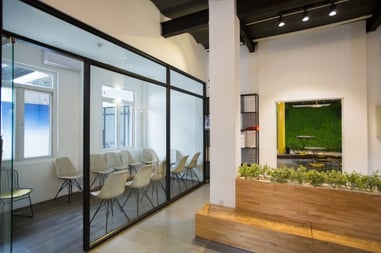Office design is a good business investment. A quality workspace design leads to a less stressful and more productive atmosphere. It’s important that employers take the physical work environment of their employees into consideration. Employees need to feel comfortable and calm in their physical work settings to produce their best work.

If your employees are having trouble staying productive or seem overly stressed, your workplace design might be contributing to the problem. Read on to learn four office design tips to help increase productivity while also reducing workplace stress.
Provide a de-stressing zone.
Create a space specifically meant for de-stressing. Employees need time away from their desks when they need a break from work. A designated area to unwind and recharge will help prevent overly stressed employees and employee burnout.
Select an unused room or designate a space of the office to transform into a de-stressing zone. Consider stocking the room or area with comfortable seating, stress-relieving games, and a speaker playing quiet relaxation tunes. Let employees know that they can excuse themselves to this area whenever they’re feeling stressed and need a break from their desk.
Here at TotalWellness, we’ve created a “Zen room” for employees to unwind and recharge when their brains need a break. We painted the walls with calming colors and added comfortable seating. The Zen room helps employees de-stress without having to take an extended lunch break away from the office.
Rethink the color scheme.
Color affects behavior. The color scheme of an office can create a calming environment and promote stress relief, or it could create the opposite effect. A workspace with all white walls can look “clinical” and create feelings of anxiety. A calming blue or green color scheme can promote feelings of tranquility and improve productivity. In fact, according to an article published by Entrepreneur, calming shades of blue and green improve efficiency, focus, and overall sense of wellbeing.
Soft neutral shades are also a good choice for an office color scheme. A Huffington Post article states that soft, neutral colors cause less eyestrain – helping to improve concentration and prevent eye fatigue. If your office is in need of a fresh paint job, consider warming up stark, white walls with a soft neutral color and add some calming blue or green accent walls or décor to help relieve stress.
Designate quiet working areas.
Quiet zones are great for productivity. Choose an area of the company that is further away from the buzz and hum of the office, and set up tables and chairs for employees to use. These areas should be reserved for employees who need a break from their desks or the noise from their co-workers while still working. Quiet zones can be great places to get work done because they can reduce distraction and increase productivity. They are less isolated than a private office or cubicle, while still maintaining a sense of “individual”, quiet space.
If extra space is available, it might be beneficial to consider adding private working zones as well. Use an empty office or unused conference room to designate as a private working area. This is similar to a quiet zone but should include doors and walls – and remain similar to a traditional office space. A private working area eliminates any chance of distraction – allowing busy employees to feel as productive as possible.
Stay mindful of comfort.
The comfort of an office is crucial to the wellbeing of employees. Keep in mind that many elements contribute to the productivity and stress levels of your workforce. This includes:
- Temperature. When employees are too hot or too cold, their productivity and mood will begin to suffer. Keep office temperatures reasonable throughout the year.
- Lighting. The best type of lighting for productivity and stress relief? Natural lighting! Employees should be exposed to natural lighting throughout the day – not just fluorescent lighting. Keep employees in areas with windows, and keep the blinds open after sunrise.
- Noise. Both an office too loud or too quiet can cause distractions and/or feelings of nervousness for employees. Evaluate the noise levels in your office and consider investing in a machine that produces white noise if needed.
- Physical comfort. Employees need to feel physically comfortable in order to maintain productivity throughout the day. Invest in quality desks, chairs, and space for your employees. Be sure employees also have the opportunity to stand and stretch throughout the day. Consider investing in standing desks or exercise balls. If standing desks aren’t in the budget, here’s how employees can make a DIY standing desk for no cost.
Remember that designing a stress-free and productive workspace doesn’t have to be complicated or pricey. By simply offering employees areas to recharge and taking their comfort into consideration, you can easily make subtle changes to improve the physical environment at your office.
Which factors of office design do you think impact employee stress and productivity the most? Let us know your thoughts in the comment section below!
Like this blog post? Share it with your employees or co-workers with this printable version of the blog!
Image created by Katemangostar - Freepik.com



